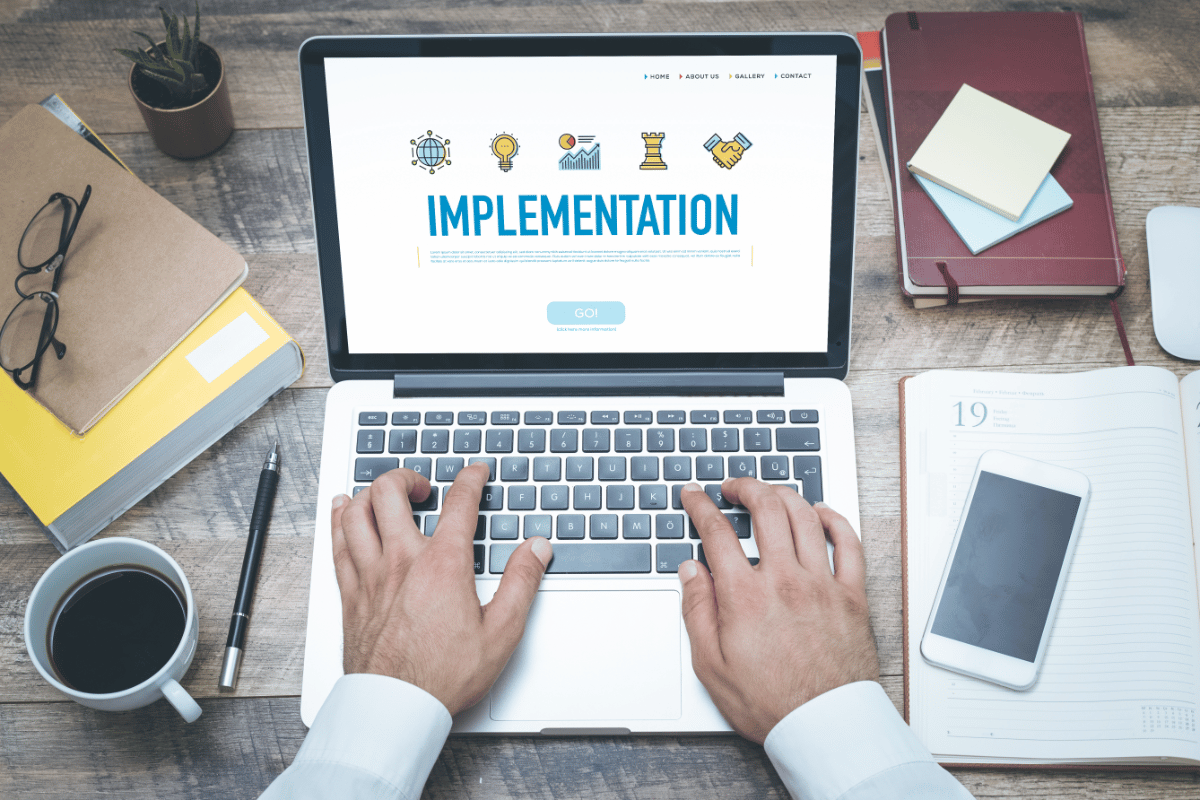Implementing Efficient Business Systems
In the fast-paced world of business, the importance of implementing efficient systems cannot be overstated. Streamlining processes, optimizing workflows, and maximizing productivity are crucial aspects that contribute to the success of any organization. However, the path to achieving these goals is not always straightforward.
It requires a strategic approach, careful planning, and a keen eye for detail. By focusing on assessing current processes, identifying key areas for improvement, and selecting the right tools, businesses can pave the way for enhanced efficiency and growth.
But what happens when challenges arise, and how can businesses navigate through the complexities of implementing these systems effectively?
Key Takeaways
- Assess current processes to identify areas for improvement.
- Implement systematic changes for streamlined operations.
- Monitor performance metrics for data-driven decision-making.
- Gather feedback for continuous refinement and sustainability.
Assessing Current Processes
In evaluating the efficiency and effectiveness of an organization’s operations, a crucial initial step is assessing the current processes in place. Process evaluation is essential to understand how tasks are currently being performed, identify bottlenecks, and pinpoint areas for improvement. By conducting a thorough analysis of the existing procedures, organizations can optimize their processes to enhance productivity and reduce waste.
Efficiency analysis plays a vital role in streamlining operations. It involves scrutinizing each step of a process to identify redundancies, inefficiencies, or unnecessary complexities. Through this evaluation, organizations can identify opportunities to streamline workflows, eliminate unnecessary steps, and enhance overall efficiency.
Optimization of processes is a strategic initiative that aims to enhance the quality and speed of operations while minimizing costs. By identifying key areas for improvement through process evaluation and efficiency analysis, organizations can implement targeted changes that lead to significant enhancements in performance. Continuous optimization ensures that processes remain effective and efficient in the ever-evolving business environment.
Identifying Key Areas for Improvement
With a focused lens on operational enhancement, pinpointing strategic areas for refinement is a fundamental step towards elevating organizational efficiency and effectiveness. To identify key areas for improvement, organizations should focus on the following:
- Process Optimization: Analyzing current workflows and procedures to streamline operations, reduce redundancies, and eliminate bottlenecks can significantly enhance overall efficiency. By identifying inefficient processes and implementing changes to optimize them, organizations can achieve greater productivity and cost-effectiveness.
- Efficiency Enhancement: Evaluating resource utilization, time management, and employee productivity can uncover areas where improvements are needed to boost efficiency. Implementing training programs, setting clear performance goals, and utilizing performance metrics can help enhance the efficiency of operations across various departments.
- Feedback Mechanisms: Establishing feedback mechanisms such as surveys, suggestion boxes, or regular performance reviews can provide valuable insights into areas that require improvement. Actively seeking feedback from employees, customers, and stakeholders can help organizations identify key areas for enhancement and drive continuous improvement initiatives.
Selecting the Right Tools
To propel operational enhancement further, the next crucial step entails strategically selecting the appropriate tools to facilitate the identified areas for improvement. When choosing tools for business systems, it is essential to consider aspects such as tool integration and customization to ensure seamless operations.
Integration capabilities allow different tools to work together harmoniously, enhancing overall efficiency. For instance, businesses handling recurring payments might use solutions like Rotessa to automate direct debit transactions, streamlining financial processes and saving time. Customization options enable tailoring the tools to specific business needs, maximizing their effectiveness in addressing key improvement areas.
Moreover, an often overlooked yet critical factor is user adoption. Tools must be user-friendly to encourage adoption and utilization across the organization. Providing adequate training is vital to ensure that employees understand how to leverage the tools to their full potential. Proper training enhances efficiency and minimizes errors, ultimately contributing to the success of the business systems implementation.
Establishing Clear Objectives
To ensure the success of any business system, it is crucial to establish clear objectives. Defining specific goals provides a roadmap for the company. Setting measurable targets allows for progress evaluation. Consistent monitoring ensures that the organization stays on track.
Define Specific Goals
Establishing clear objectives is essential for creating a roadmap towards achieving specific goals within efficient business systems. When setting objectives, it is crucial to consider the following:
- Clarity: Objectives should be well-defined and easily understood by all stakeholders involved in the business processes.
- Relevance: Ensure that the objectives set are aligned with the overall vision and mission of the organization to drive meaningful progress.
- Measurability: Objectives should be quantifiable, allowing for the measurement of progress towards their achievement. This helps in tracking performance and making necessary adjustments to stay on course.
Set Measurable Targets
Building upon the foundation of clearly defined objectives, the next critical step in creating efficient business systems is setting measurable targets that align with those objectives. By establishing specific, measurable targets, organizations can effectively track progress and evaluate performance metrics to ensure they are on course to achieve their desired outcomes. Setting measurable targets enables businesses to focus their efforts, allocate resources efficiently, and make informed decisions based on real-time data. The table below illustrates the importance of setting measurable targets in driving success and achieving results.
| Benefits of Setting Measurable Targets | Description | Impact |
|---|---|---|
| Improved Target Tracking | Setting clear targets allows for precise monitoring of progress. | Ensures goals are met efficiently. |
| Enhanced Performance Metrics | Measuring performance against targets provides valuable insights. | Helps in identifying areas for improvement. |
| Strategic Decision Making | Data-driven approach aids in making informed business decisions. | Enhances overall operational efficiency. |
Monitor Progress Consistently
Ensuring consistent monitoring of progress is a fundamental aspect of establishing clear objectives within efficient business systems. This practice allows businesses to stay on track and make informed decisions based on real-time data.
To effectively monitor progress and achieve set objectives, businesses should focus on:
- Progress tracking: Implementing robust systems to track key performance indicators (KPIs) and milestones regularly.
- Data analysis: Utilizing data analytics tools to interpret progress data accurately and identify areas for improvement.
- Performance monitoring: Regularly assessing individual and team performance against set objectives to ensure alignment and progress.
Training Staff on New Systems
To ensure a smooth transition to new systems, providing hands-on practice opportunities for staff is essential.
Additionally, ongoing support and training sessions will help employees feel confident and proficient in utilizing the new systems effectively.
Hands-On System Practice
Implementing a comprehensive hands-on system practice is essential for effectively training staff on new systems in a business environment. This approach allows employees to engage directly with the system, enhancing their understanding and proficiency.
To ensure successful hands-on system practice, consider the following:
- Hands-on Simulations: Create interactive simulations that mimic real-world scenarios to give employees practical experience in using the new system.
- Practical Workshops: Conduct workshops where employees can apply their theoretical knowledge in a hands-on setting, reinforcing their learning and problem-solving skills.
- Feedback Mechanisms: Establish feedback channels for employees to share their experiences, ask questions, and receive guidance during hands-on practice sessions. This fosters continuous improvement and a supportive learning environment.
Ongoing Staff Support
Building upon the foundation of hands-on system practice, ongoing staff support plays a crucial role in equipping employees with the necessary skills to effectively utilize new systems within a business setting. Staff engagement is key during this phase as it ensures that employees are actively involved in the learning process, increasing their understanding and retention of the new system functionalities.
Moreover, providing performance feedback is essential to address any gaps in knowledge or skills promptly. By offering constructive feedback, employees can continuously improve their proficiency with the new systems, enhancing overall operational efficiency. This ongoing support not only boosts staff confidence but also contributes to the successful integration of efficient business systems.
Implementing Systematic Changes
Incorporating systematic changes is a critical component of optimizing business operations for enhanced efficiency and effectiveness. When implementing systematic changes, organizations must focus on the following key aspects:
- Change Management: Effective change management is essential to ensure that the transition to new systems or processes is smooth and well-received by employees. This involves clear communication, training programs, and addressing any concerns or resistance that may arise during the implementation process.
- Process Optimization: Systematic changes should aim to streamline processes, eliminate bottlenecks, and enhance overall productivity. This may involve reevaluating current workflows, identifying areas for improvement, and implementing best practices to optimize operational efficiency.
- Technology Integration: Leveraging technology solutions can greatly support systematic changes by automating tasks, improving data accuracy, and enabling real-time monitoring of key performance indicators. Integrating new technologies into existing systems can drive innovation and create a more agile and responsive business environment.
Monitoring Performance Metrics
Monitoring performance metrics is essential for businesses to track their progress and make informed decisions.
Key Performance Indicators offer a clear snapshot of specific goals, while data-driven decision-making ensures strategies are based on facts rather than assumptions.
Continuous improvement strategies then utilize these metrics to refine processes and enhance overall efficiency.
Key Performance Indicators
Implementing a well-defined set of Key Performance Indicators is essential for gauging the effectiveness and efficiency of business operations. Key Performance Indicators (KPIs) serve as measurable values that demonstrate how effectively a company is achieving its key business objectives. Through proper performance measurement and data analysis, organizations can track progress, identify areas for improvement, and make informed decisions to drive success.
To ensure KPIs are effective, they should be specific, relevant to the business goals, and easily measurable. Additionally, KPIs need to be regularly monitored and reviewed to adapt to changing business environments and ensure continuous improvement. By leveraging KPIs, businesses can enhance their strategic planning and operational performance.
Key Points:
- Specific and Measurable: KPIs should be clear and quantifiable.
- Alignment with Business Goals: KPIs must directly relate to the organization’s objectives.
- Regular Monitoring: Consistent tracking and analysis are crucial for KPI effectiveness.
Data-Driven Decision Making
A data-driven approach to decision making is crucial for businesses seeking to optimize performance through informed and strategic insights. By utilizing data analysis, organizations can effectively monitor performance metrics and make well-informed decisions to drive growth and success. The process of data analysis involves collecting, interpreting, and presenting data in a way that facilitates decision making. Decisions based on data help in identifying trends, areas for improvement, and potential opportunities for business growth. To illustrate the importance of data-driven decision making, consider the following table showcasing key performance metrics and their impact on decision making:
| Metric | Description | Importance | Action Required |
|---|---|---|---|
| Revenue Growth | Percentage increase in sales | High | Allocate more resources |
| Customer Churn Rate | Percentage of lost customers | Moderate | Implement retention strategies |
| Conversion Rate | Percentage of converted leads | High | Optimize marketing tactics |
| Inventory Turnover | Rate at which inventory sells | Moderate | Adjust ordering processes |
Continuous Improvement Strategies
To enhance operational efficiency and drive sustainable growth, organizations must adopt continuous improvement strategies that focus on monitoring key performance metrics. Continuous innovation and process optimization are crucial components of successful business operations.
Here are three key strategies for implementing continuous improvement:
- Regular Performance Reviews: Conduct frequent evaluations of key performance indicators to identify areas for improvement and track progress over time.
- Employee Training and Development: Invest in training programs to ensure that employees are equipped with the necessary skills to drive innovation and optimize processes.
- Feedback Mechanisms: Implement systems for collecting feedback from customers, employees, and stakeholders to gain valuable insights for refining business strategies and enhancing overall performance.
Gathering Feedback From Stakeholders
Engaging with stakeholders to gather feedback is a critical component of developing efficient business systems. Stakeholder engagement ensures that the systems implemented meet the actual needs of those involved. Effective communication is key in this process, as it allows for a clear exchange of ideas and expectations. By actively involving stakeholders, businesses can gain valuable insights into what works well within current processes and where improvements are needed.
Feedback analysis is a crucial step following the collection of input from stakeholders. It involves carefully reviewing and interpreting the feedback received to identify common themes, concerns, and suggestions. This analysis enables businesses to prioritize areas for improvement and develop strategies to address them effectively.
Moreover, securing stakeholder buy-in is essential for successful implementation of any system changes. By involving stakeholders from the early stages of gathering feedback, businesses can increase the likelihood of acceptance and support for proposed modifications. Ultimately, engaging with stakeholders and effectively analyzing their feedback are fundamental in driving continuous improvement and ensuring the efficiency of business systems.
Iterating and Refining Systems
In the process of enhancing business systems, the iterative refinement of processes is a pivotal strategy for optimizing efficiency and performance. System optimization and process enhancement go hand in hand to ensure that operations are streamlined and yield the desired outcomes.
Here are three key aspects to consider when iterating and refining systems:
- Continuous Monitoring: Regularly assess the performance of the current system to identify bottlenecks or inefficiencies that need attention. Monitoring key performance indicators (KPIs) allows for data-driven decision-making and targeted improvements.
- Feedback Integration: Incorporate feedback from stakeholders, employees, and customers into the refinement process. Their insights can provide valuable perspectives on what areas need enhancement and what is working well within the system.
- Agile Approach: Adopt an agile methodology to iterate on systems quickly and adapt to changing business requirements. Breaking down the refinement process into smaller, manageable tasks enables swift adjustments and ensures that the system remains flexible and responsive to evolving needs.
Ensuring Long-Term Sustainability
Building upon the foundation of iterative refinement in business systems, the focus now shifts towards ensuring the long-term sustainability of these optimized processes. Sustainability strategies play a vital role in maintaining efficiency over time.
By implementing resource optimization techniques, businesses can ensure that their processes remain effective without excessive strain on resources. Cost efficiency is another crucial aspect to consider when aiming for long-term sustainability. Companies should seek to minimize expenses while maximizing output to secure their financial stability in the long run.
Moreover, integrating eco-friendly practices into operations not only benefits the environment but also enhances the reputation of the business in the eyes of environmentally conscious consumers. Embracing sustainable practices is not merely a trend but a strategic decision that can lead to increased profitability and resilience.
Conclusion
In conclusion, implementing efficient business systems requires a methodical approach that includes:
- Assessing current processes
- Identifying key areas for improvement
- Selecting the right tools
- Establishing clear objectives
- Training staff
- Monitoring performance metrics
- Gathering feedback
- Iterating and refining systems
- Ensuring long-term sustainability
For example, a retail company implemented a new inventory management system that reduced stockouts by 30% and increased overall sales by 15%, showcasing the impact of efficient business systems on organizational success.







